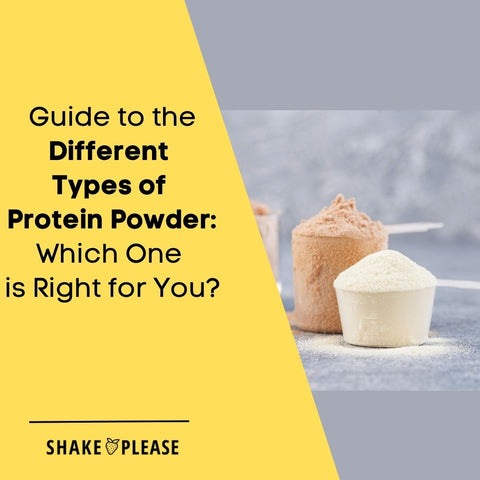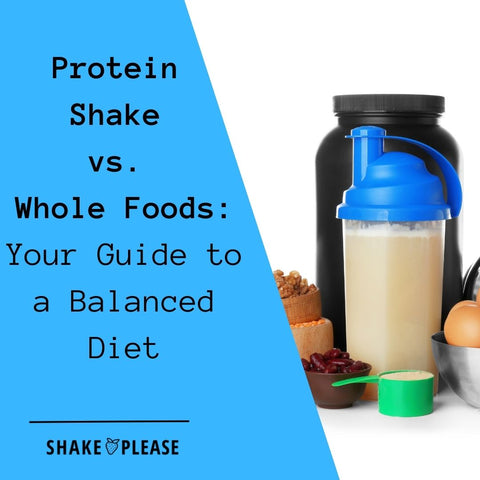
If you're curious about different types of protein powder, you've come to the right place.
Protein powder has become increasingly popular among fitness enthusiasts, athletes, and health-conscious individuals. It is a convenient and effective way to supplement your protein intake and support muscle growth and recovery.
With so many options available in the market, it can be overwhelming to choose the right protein powder for your needs. In this comprehensive guide, we will explore the different types of protein powder including smoothies with protein powder and help you understand which one is best suited for you.
Whey Protein Powder
Whey protein powder is one of the most popular and widely available options. It is derived from milk during the cheese-making process. Whey protein is a complete protein, meaning it contains all essential amino acids that the body needs. It is quickly absorbed by the body, making it an ideal choice for post-workout recovery. Whey protein comes in various forms, including whey protein concentrate, isolate, and hydrolysate.
Whey protein concentrate contains a higher amount of carbohydrates and fats compared to isolate and hydrolysate. It is a cost-effective option and provides a good balance of protein and other nutrients.
Whey protein isolate undergoes further processing to remove lactose and fat, making it a suitable choice for those with lactose intolerance or strict dietary requirements. Whey protein hydrolysate is pre-digested, allowing for even faster absorption. It is often used by athletes and individuals with specific dietary needs.
IS IT HEALTHY TO ADD PROTEIN POWDER TO SMOOTHIES?
Casein Protein Powder
Casein protein powder is another type of protein derived from milk. Unlike whey protein, casein is digested and absorbed slowly by the body. This slow release of amino acids makes it an excellent option for promoting muscle recovery and preventing muscle breakdown during periods of fasting, such as overnight.
Casein protein is rich in glutamine, an amino acid important for muscle repair and immune function. It is commonly used as a nighttime protein supplement or as a meal replacement for extended periods of fasting.
Soy Protein Powder
Soy protein powder is derived from soybeans and is a suitable option for vegans and vegetarians. It is a complete protein and provides all essential amino acids. Soy protein is also rich in antioxidants and phytochemicals, which have been associated with various health benefits.
It is a versatile protein powder that can be used in smoothies, baked goods, and other recipes. However, it is worth noting that some individuals may have allergies or sensitivities to soy products.
Pea Protein Powder
Pea protein powder is a plant-based protein option that is derived from yellow split peas. It is a high-quality protein source and contains all essential amino acids. Pea protein is easily digestible and has been shown to support muscle growth and recovery.
It is also hypoallergenic, making it a suitable choice for individuals with food allergies or intolerances. Pea protein powder is often used by vegans, vegetarians, and those following a plant-based diet.
AWESOME BENEFITS OF SMOOTHIES WITH CHOCOLATE PROTEIN POWDER
Rice Protein Powder
Rice protein powder is made from brown rice and is another plant-based protein option. It is hypoallergenic and easily digestible. Rice protein is also suitable for individuals with dietary restrictions, such as gluten or dairy intolerance.
However, it is important to note that rice protein is not a complete protein on its own, as it lacks some essential amino acids. Combining rice protein with other plant-based protein sources can help ensure a complete amino acid profile.
Hemp Protein Powder
Hemp protein powder is derived from the seeds of the hemp plant. It is a complete protein and provides all essential amino acids. Hemp protein is also rich in omega-3 fatty acids, fiber, and other beneficial nutrients.
It has a slightly nutty flavor and can be easily incorporated into smoothies, baked goods, and other recipes. Hemp protein is a popular choice among vegans, vegetarians, and individuals looking for a plant-based protein source.
Egg Protein Powder
Egg protein powder is made from egg whites and is a highly bioavailable source of protein. It is a complete protein and contains all essential amino acids. Egg protein is easily digested and rapidly absorbed by the body, making it an excellent choice for muscle recovery and growth.
It is also low in carbohydrates and fat, making it suitable for those following a low-calorie or low-carb diet. However, individuals with egg allergies should avoid egg protein powder.
Plant-Based Protein Powder Blends
Plant-based protein powder blends are a combination of different plant-based protein sources to provide a complete amino acid profile. These blends often include a mix of pea, rice, hemp, and other plant proteins.
Plant-based protein blends offer the benefits of multiple protein sources and are suitable for individuals following a vegan, vegetarian, or plant-based diet. They provide a well-rounded nutritional profile and can support muscle growth and recovery.
Smoothies with Protein Powder
Protein powder can be easily incorporated into smoothies to create a nutritious and satisfying meal or snack. Here are a few ideas for protein-packed smoothies that you can enjoy:
- Berry Blast: Blend together a handful of mixed berries, a scoop of your favorite protein powder, a banana, and a splash of almond milk. This refreshing smoothie is packed with antioxidants and provides a good source of protein.
- Green Goddess: Combine a handful of spinach or kale, a scoop of plant-based protein powder, a frozen banana, a tablespoon of almond butter, and almond milk. This smoothie is rich in fiber, vitamins, and minerals, making it a perfect post-workout option.
- Tropical Paradise: Blend together frozen mango chunks, pineapple, coconut water, a scoop of whey protein powder, and a handful of spinach. This tropical smoothie is not only delicious but also provides a good source of protein and essential nutrients.
Benefits of Consuming Protein Powder
Before diving into the specifics of each type of protein powder, let's first discuss the benefits of incorporating protein powder into your diet. Protein is an essential macronutrient that plays a crucial role in building and repairing tissues, supporting immune function, and maintaining overall health.
Protein powder offers several advantages:
- Convenient and Portable: Protein powder can be easily mixed with water or your preferred beverage, making it a convenient option for those on the go.
- Muscle Growth and Recovery: Protein is the building block of muscle tissue. Consuming protein powder after a workout can help promote muscle growth and aid in recovery.
- Weight Management: Protein is known to increase satiety, which can help curb cravings and reduce overall calorie intake, supporting weight management goals.
- Nutrient Density: Protein powders often contain additional nutrients like vitamins, minerals, and amino acids, providing a concentrated source of nutrition.
How to Incorporate Protein Powder into Your Diet
Incorporating protein powder into your diet is simple and versatile. Here are a few ideas on how to include protein powder in your daily routine:
- Post-Workout Shake: Mix a scoop of your preferred protein powder with water or your favorite beverage immediately after your workout to support muscle recovery.
- Breakfast Boost: Add a scoop of protein powder to your morning smoothie, oatmeal, or pancake batter to increase the protein content of your breakfast.
- Snack Options: Create protein-packed snacks by incorporating protein powder into energy balls, homemade protein bars, or yogurt parfaits.
- Baking and Cooking: Use protein powder as a substitute for flour in baking recipes or add it to soups, sauces, or other savory dishes to boost the protein content.
Protein Powder Recipes and Ideas
Here are a few protein powder recipes to inspire you:
- Protein Pancakes: Mix protein powder, oats, egg whites, and a mashed banana to create a delicious and protein-rich pancake batter. Cook as you would regular pancakes and enjoy with your favorite toppings.
- Protein Energy Balls: Combine protein powder, nut butter, honey, and rolled oats in a bowl. Mix until well combined and roll into bite-sized balls. Store in the refrigerator for a quick and nutritious snack.
- Chocolate Protein Smoothie: Blend together almond milk, chocolate protein powder, a frozen banana, and a tablespoon of peanut butter for a decadent and protein-packed smoothie.
Choosing the Right Protein Powder for Your Goals and Dietary Needs
When choosing a protein powder, it is essential to consider your specific goals and dietary needs. Here are a few factors to consider:
- Personal Goals: Are you looking to build muscle, lose weight, or maintain overall health? Different protein powders may be more suitable for specific goals.
- Allergies or Intolerances: If you have allergies or intolerances to certain ingredients, it is important to choose a protein powder that meets your dietary restrictions.
- Taste and Texture: Protein powders come in a variety of flavors and textures. It is important to choose a protein powder that you enjoy consuming to ensure consistency in your protein intake.
- Quality and Purity: Look for protein powders that have undergone third-party testing for quality and purity. This ensures that you are consuming a safe and effective product.
Tips for Buying and Storing Protein Powder
To ensure the quality and freshness of your protein powder, here are a few tips for buying and storing:
- Read Labels: Carefully read the labels and ingredient lists of protein powders to ensure they meet your dietary needs and preferences.
- Store Properly: Keep your protein powder in a cool, dry place away from direct sunlight and moisture. This will help maintain its freshness and prevent clumping.
- Use within Expiry Date: Protein powders have an expiry date for a reason. Use them within the specified timeframe to ensure maximum effectiveness and safety.
Conclusion
Protein powder is a versatile and convenient way to enhance your protein intake and support your health and fitness goals.
By understanding the different types of protein powder and their benefits, you can make an informed decision on which one is best suited for you. Consider your goals, dietary needs, and personal preferences when choosing a protein powder, and experiment with various recipes and ideas to incorporate it into your diet.
Remember to consult with a healthcare professional or registered dietitian before making any significant changes to your diet or supplementation routine. Start exploring the world of protein powders and protein smoothies and enjoy the benefits they have to offer.
Now that you've learned about the different types of protein powder, you can make informed choices.





